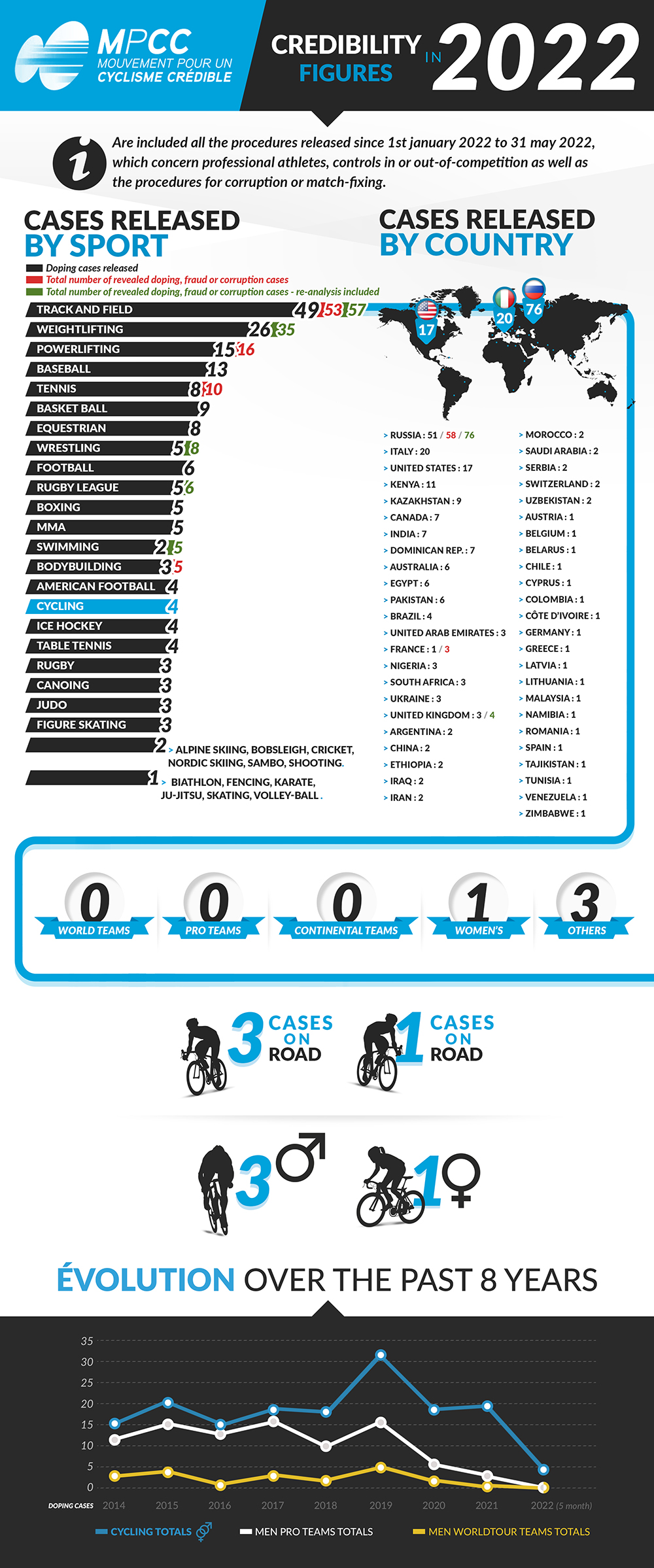While more doping cases have come to light this year, cycling has so far been spared this increase. In the professional road teams, doping cases are even non-existent in this first semester. This is something we have never seen in the 9 years we have been monitoring these figures.
The fight against doping seems to be on a roll this year! On average, since the beginning of the year, nearly 50 revelations per month have been made public. This figure compares with 35 revelations per month in recent years.
However, there is no novelty concerning the most affected sports during the first 5 months of the year: athletics, ahead of weightlifting and baseball (in spite of a delayed start of the season and tests resuming only in early April). Russia remains (by far!) the country most often singled out, ahead of the United States and Italy.
What explains this increase in cases?
With the decline in the intensity of the pandemic and the Olympic Games (Tokyo and Beijing), the pace of testing has increased significantly in 2021 and 2022. There is always a time lag between the taking of samples and the revelation of doping cases.
But the most spectacular increase in suspensions came from Russia, a sporting nation largely discredited since 2016 by the revelations of Grigory Rodchenkov, former director of the Moscow laboratory, which had led the IOC to suspend Russia from the Olympics in 2018, 2020 and 2022. Today, to regain the lost confidence, the anti-doping agency Rusada is showing some diligence. In the last 5 months, it has suspended four doctors for fraud in athletics, but also trainers in the world of bodybuilding and athletic strength.
At the same time, under the leadership of WADA, the reanalysis of suspicious samples dating from 2008-2015 and concerning Russian athletes is still ongoing. Eighteen new procedures have resulted in sanctions in weightlifting (9 cases), athletics (4), wrestling (3) and swimming (3).
The cycling situation
In the case of top-level athletes, only three new procedures were initiated in cycling and only one sanction was handed down at the beginning of the year:
- Aigul Gareeva (RUS). The 21-year-old former European Junior Champion was provisionally suspended for a third failure to register on the ADAMS platform.
Source: TASS news agency, 18/01/22. - Toon Aerts (BEL). The two-time winner of the Cyclo-cross World Cup tested positive for lezotrole, a substance generally used to cure breast cancer (!) which is on the list of products banned by WADA because of its masking effects. The Belgian of the Cyclo-cross team Baloise-Trek-Lions has been provisionally suspended.
Source: himself, 15/02/2022. - Danilo Hondo (GER). Retired from competition since the end of 2014, the former German sprinter has been sanctioned with a 5-year suspension by the Munich Criminal Chamber, after his confession in the Aderlass judicial investigation involving athletes from several disciplines (cycling, Nordic skiing, triathlon and American soccer).
Source: Swiss Olympic, 13/05/2022. - Samandar Sultanov (UZB). Aged 17, he was provisionally suspended after a positive test carried out at the end of March, during the Asian Jr. Road Championship, which he had just won in Tajikistan. This test revealed the presence in his urine of methasterone, an anabolic steroid that has never been marketed for medical purposes.
Source: UCI, 30/05/2022.
None of the cyclists concerned belong to a professional road team (a unique situation since the Festina case!).
The MPCC had the opportunity to specify in its 2021 review that, for the first time since the creation of the World Tour in 2005, no doping proceedings had involved a team in this world division. As for the last proven case in the Tour de France, it is worth noting that it goes back to 2015.
This continuous decline in the number of doping proceedings began in 2020. But the trend is much more noticeable among professional road cyclists. In recent years, only suspected cases among women have increased. There have been six per year since 2019 (compared to one or two cases per year previously). The increase in the number of teams and competitions that accompanies the professionalization of the women’s peloton is probably no stranger to this increase.
In a recent joint press conference, both the UCI and the ITA (International Testing Agency) pointed out that even if there were no more doping violations, this does not mean that the doping has disappeared.
In light of this, the MPCC reiterates its full commitment to the ITA’s recommendations, detailed this month, to increase the resources for an effective fight against cheaters.

